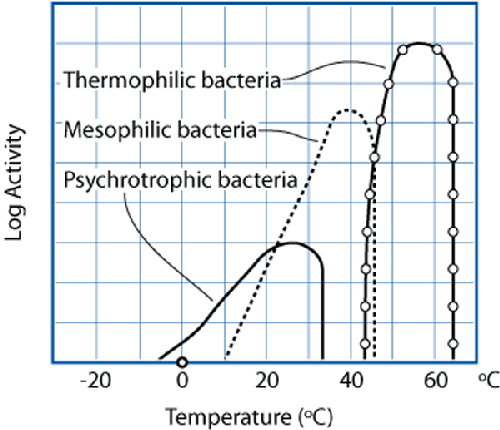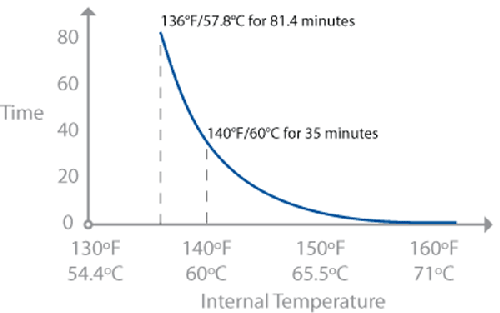1. How to Prevent Foodborne Illness Caused by Bacteria
Salmonella: it’s the poster child of foodborne illness. And for good reason.
Salmonella accounts for a full 30% of the roughly 1,800 deaths due to foodborne illnesses
per year in the U.S.—more than any other cause in this category. Salmonella’s ideal
breeding temperature? Around 100°F / 38°C—close to body temperature. Clearly it likes us.
And according to some reports, the most likely food that’ll harbor the bacteria in our
modern food supply isn’t chicken or meats, but produce. Wash your veggies!
The odds of dying from foodborne illness are actually surprisingly low, especially
considering the media attention given to it. But the media attention isn’t unmerited: 1 in
8 of us will contract illnesses from foods in any given year, and about 1% of those cases
will require hospitalization, according to the U.S. Centers for Disease Control and
Prevention (CDC).
Contracting a foodborne illness is a game of probabilities: a single bacterium of
salmonella isn’t likely to cause a problem, but given a few dozen cells, the odds change.
E. coli is similar: only a few bacteria are necessary for the
possibility of infection. A few strains are decidedly nasty, O157:H7 being the most talked
about.
It’s not
always “just a handful” of cells, though. Contracting listeriosis requires ingesting
somewhere around 1,000 organisms of Listeria monocytogenes, which
tends to be present in animal products and multiplies at temperatures as low as 34°F /
1°C. Luckily, listeriosis isn’t an issue for many of us, but it can cause complications
for at-risk groups—especially pregnant women, where the baby is at risk. This is why
pregnant women are told to avoid foods such as soft and surface-ripened cheeses, deli
salads, raw milk, hot dogs, and shrimp; to ensure that chicken is thoroughly cooked; and
to be careful with previously cooked ready-to-eat foods.
Bacteria can be grouped into three broad categories, based on the
temperature at which they are most active. There are bacteria that remain active in
food above 122°F / 50°C, but these are only beneficial (e.g., Bacillus
coagulans) or spoilage bacteria, and not related to foodborne illness. From
a taste perspective, we’re extremely lucky that no thermophilic bacteria cause
foodborne illness; otherwise, we’d have to cook foods to higher temperatures to kill
them.
GRAPH BASED ON E. ANDERSEN, M. JUL, AND H. RIEMANN (1965), “INDUSTRIEL
LEVNEDSMIDDEL-KONSERVERING,” COL. 2, KULDEKONSERVERING, COPENHAGEN: TEKNISK
FORLAG)

Salmonella gets most of the limelight in the media for a couple of reasons, though:
it’s hardy—that is, able to survive in the environment for longer periods of time and at
temperatures above what most other common-to-food bacteria can tolerate—and it’s
surprisingly prevalent, affecting 1.4 million Americans a year on average.
Caliciviruses—a family of viruses, norovirus being the best known—are also getting
more attention these days, and deservedly so; these are typically spread by a sick
individual preparing food for others. If you’ve spent a night “praying to the porcelain
god”—diarrhea, vomiting, chills, headache—you can probably thank salmonella or norovirus
for the experience.
Note:
If you’re sick, don’t cook for others. If you’re around someone sick, wash your
hands. Often.
Now, pay attention, because this is important.
Salmonella is killed at 136°F / 58°C only when held
for a sufficient length of time. Seeing your thermometer
register an even hotter temperature—say, 140°F / 60°C—does not guarantee that the food
will be free of salmonella. Think of it like being in a hot desert: you can survive 136°F
/ 58°C heat for a while, but if you’re exposed to it for too long, eventually you will
die. The same is true for bacteria like salmonella: given a short amount of time at a
particular temperature, the bacteria might survive, but given a longer exposure, they will
eventually die.
Salmonella actually lives in a temperature range of 35–117°F / 2–47°C according to the
FDA’s “Bad Bug Book.” The 136°F / 58°C temperature is based on what the FDA Food Code
gives as the lower bound for pasteurization.
Back to the desert analogy. Let’s say an average human can survive for four hours in
136°F / 58°C heat. Given 100 people in a desert, though, this doesn’t mean all 100 people
will be alive at 3 hours, 59 minutes and all suddenly drop dead one minute later. The same
is true for bacteria that might be hitching a ride on that chicken you’re about to cook:
the proteins in the bacteria don’t all spontaneously denature at a specific temperature.
It’s a probability thing: as the temperature goes up, the probability of the molecular
structure of each kind of protein denaturing increases. There’s not an exact temperature
at which this occurs, like there is when a solid melts into a liquid.
Note:
When talking about reducing the number of bacteria in food, scientists use the term
log10 reductions. A single
log10 reduction is simply the reduction of the number of
bacteria present by a factor of 10; a 7 log10 reduction is a
10,000,000-fold reduction. The USDA’s Food Safety and Inspection Service (FSIS) division
is responsible for providing guidelines relating to the number of log reductions
necessary to achieve an acceptable quantity of bacteria. Given that different kinds of
meats have different properties—different amounts of fats, water, etc.—the number of log
reductions necessary to reduce the bacterial count from a potential starting amount to
an acceptable number differs. Hold time for sufficient pasteurization is also affected
by variables such as how smooth the surface of the food is and its chemical composition
(e.g., nitrite levels).
One important caveat about pasteurization: sometimes it’s not the bacteria themselves
that are the issue, but the toxins they produce. While appropriate cooking might safely
reduce the bacterial count, the toxins themselves, such as those produced by B.
cereus, can be heat-stable. Refrigeration of meats is therefore critical to
prevent the multiplication of bacteria in the meat tissue. Remember the simple food safety
rule mentioned earlier: avoid holding foods at temperatures between 40°F / 4°C and 140°F /
60°C for more than two hours. This includes the amount of time it takes to bring the food
from fridge temperature to a safe hot temperature! While it is true that the 40-to-140°F /
4-to-60°C rule for two hours is a vast simplification of the real multiplication rates of
bacteria, it’s a simple rule accepted by the food industry, and rarely is there any need
to skirt it.
Note:
Who said scientists don’t have a sense of humor? Try saying B.
cereus out loud.
At 140°F / 60°C, a hold time of 35 minutes is necessary for chicken with 12% fat to
achieve a 7-log10 reduction. The time drops in leaner chickens;
chicken meat with 1% fat requires 25.2 minutes at 140°F / 60°C. Longer hold times are
okay; these times are minimum
times. Chicken meats can be infected with salmonella throughout the tissue. While sick
birds are supposed to be culled, it’s still possible for them to go unnoticed.
Minimum amount of time in minutes required to cook chicken safely
(assuming 7-log10 reduction in chicken with 12%
fat).

“Why then,” I bet you’re thinking, “do ‘they’ say to cook chicken to a temperature of
165°F / 74°C?” “They” happen to be the fine folks at the CDC, and what they say
specifically is:
All poultry should be cooked to reach a minimum internal temperature of
165°F [74°C].
Why 165°F / 74°C? One reason is that this is the temperature at which salmonella dies
a quick death. From a “keeping it simple” perspective, seeing 165°F / 74°C on the
thermometer is an easy guideline. Even if your thermometer is miscalibrated or you
misprobe the meat and it’s only reached a temperature of 155°F / 68°C, the pasteurization
time for chicken at this temperature is less than a minute, which you’re likely to exceed.
The 165°F / 74°C guideline effectively removes the variable of time, making it an easier
to follow (harder to screw up) rule.
Since none of the bacteria related to foodborne illness
can survive, let alone reproduce, at moderate temperatures, holding food above 140°F /
60°C indefinitely is safe. This is why the soup at your local lunch counter can be kept
hot all day long in a heat-controlled container and why hot buffets use steam baths to
keep the foods warm. While you might be perplexed by the idea of storing foods hot, from a
bacterial control perspective, it’s actually safer than storing them in the fridge:
bacteria are unable to survive in the hot environment, while storing them in the fridge
generally only slows their reproduction.
Note:

The serving spoons, by the way, are supposed to stay in the food, so that they too
stay above 140°F / 60°C. Otherwise, that mashed potato clinging to the serving spoon at
room temperature will be a potential hangout spot for bacteria.
In the U.S., the FSIS and the FDA run testing programs to monitor the food supply.
Both agencies have the ability to hold foods at processing plants, to request voluntary
recalls, and to outright seize product through court order if it comes to that. Still,
there’s a lot of food going through the system, and lapses in protocol happen (probably
more than we want to know about). A lot of work is done in identifying hazard points in
the food system (HACCP—Hazard Analysis & Critical Control Points), but still, errors
happen. What’s a nervous food geek to do?
The most common vector for foodborne illness is surface contamination, either from
contaminated water sprayed on vegetables during farming or from fecal contamination in
meats during slaughter and processing. How does this affect you when cooking? Since it’s
the surface of most products that becomes contaminated, it’s the surface that needs to be
pasteurized. Pan searing a steak heats the outer portion well beyond any temperature that
bacteria can survive. Likewise, steaming vegetables thoroughly heats their surface.
Note:
When cooking vegetables in the microwave, use a container with the lid mostly closed
and with a small amount of water inside: the microwave will boil the water, and the
container will keep the steam in contact with the vegetables.
What about hamburgers? Well, they’re all outside, in the sense that surface
contamination will have been ground throughout the meat. Industry calls things like steak
whole-muscle intact meat, as opposed to ground meat. When looking
at consumer cooking guidelines, the temperatures given are lower for whole-muscle intact
than ground meats, presumably because the outside of a whole muscle cut will be well
beyond pasteurized by the time the middle comes to temperature.
In a clean bowl,
work together using your fingers: 1 pound (500g) ground beef or
hamburger 1 teaspoon (6g) Worcestershire sauce
(optional) 1 teaspoon (5g) salt ½ teaspoon (1g) ground pepper (fresh, not
preground)
Form into three or four patties. Using either a grill (radiant heat from below) or
broiler (radiant heat from above), cook on each side for about 5 minutes, until the
internal temperature registers at 160°F / 71°C. If grilling, add cheese (try mild cheddar or Provolone) after flipping the first
time. If broiling, add the cheese after reaching temperature and return to broiler for
half a minute or so, until the cheese has melted. 
Notes Yes, you can haz cheezburger. Just cook it properly. Use a digital
thermometer and make sure the internal temperature reaches 160°F / 71°C. You can
pull it off the grill when it is a few degrees lower, because carryover will take
it up to temperature. Fun fact: “hamburger” can have beef fat added to it; “ground beef”
cannot.
|
When cooking a hamburger, the USDA says to heat the meat to 160°F / 71.1°C—high enough
to kill any common bacteria but also high enough that both actin and myosin proteins will
denature, leading to a drier burger. Since fats help mask dryness in meat, using ground
beef that has more fat in it will lead to a juicer burger. Alternatively, if you have a
way of cooking your burger to a lower temperature and then holding it at temperature long
enough to pasteurize it, you could avoid denaturing the actin proteins while still
pasteurizing the meat.
Note that change in color is not an accurate indicator of doneness. Myoglobin,
oxymyoglobin, and metmyoglobin can begin to turn grey starting around 140°F / 60°C, and
they can also remain pink at 160°F / 71°C if the pH is at or about 6.0. Use a thermometer
when cooking ground meats and poultry!